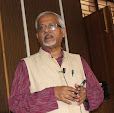
Durga puja is one of the most important festivals of India. Unmatched skills of creating beautiful idols of Durga come to the fore during this festive occasion. Here are some interesting aspects of how artisans breathe life in the images of Durga.
CJ: Arindam Roy, 7 Oct 2007 Views: 4231 Comments: 11
THOUSANDS OF idol makers throughout the country are working day and night. They are busy finishing the images of the war-goddess Durga. “Our deadline is approaching fast. We have to deliver about 30 sets of Durga idols, by October 15 / 16. My team of eight people has not slept for more than three hours, for weeks, now” said Sudeb Pal, an idol-maker from Darbhanga, Allahabad, talking to merinews on phone.
He explained that a special kind of ‘athalo mati’ (sticky soil) is needed for making these clay idols. The soil has to be prepared, painstakingly. But, before that the ‘kathamo’ (stick and hay structure) is prepared. “No matter, how large the idol is it rests on three main, sturdy bamboos. A structure of spliced bamboos and hay, tied at places, attached to the main structure start creating the image.”
In east UP, 19 idol makers in the twin city of ‘Kashi-Prayag’ (Varanasi and Allahabad) make about 1500 sets of idols.
Tinkouri Pal, another artisan from Colonelganj, adds, “A dough-like mixture of clay is kneaded thoroughly. It has to have the right proportion of moisture (water content). If it is less, the idol will crack and chip, if more, the clay will drip.”
Banshi Pal, an artisan from Pandey Haveli, Varanasi, informed, “Before mixing the clay, it is necessary to get some clay from under the feet of prostitutes; otherwise the idol cannot be cast.”
There were varying opinions of how the tradition of getting the clay from under the sex worker’s feet might have evolved. Robin Pyne, in his mid-twenties, an art college graduate from Kolkata reasoned that earlier, there were no art schools or colleges. It was not possible for the artists of the yesteryears to study anatomy of the models. In fact, even these days, some of the better looking young girls, many of them from red light areas, pose as nude models for art college students. “The only option left for these idol makers was to visit the prostitutes, with their gurus. I have heard from someone that the young lads were blindfolded and had to feel the various parts of the woman’s body, particularly the breasts, waist and hips, alongwith the limbs. They had to cast it in clay. It took years of training. To give it a certain religious sanction, it is possible that the clay trampled by a prostitute was made a part of the religious tradition.”
Mohini, a student of sculpting, felt that a study of a live woman’s body might have been important, though not necessary. An artist sees many things with his eyes. He / she is a keen observer. A sense of proportion is ingrained in that person, which is honed by rigorous training. She asked, “Does it mean that the artists might have actually felt the body of a lion, owl, rat, peacock or swan – the various vahans (vehicles) of the gods and goddesses? This argument is too simplistic. It would be like saying that an architect must get a physical feel of the building or monument before he constructs it. The tradition is there. It’s difficult to trace the exact reason for it…I do not know how it came about, but one thing is certain, the practice is gender sensitive and very honourable.”
In an earlier interview with this scribe, Prof Biswanath Bhattacharya, an Oriental scholar and former head of Sanskrit and Pali, Banaras Hindu University, smiled and said, “Durga symbolises the combined strength of all gods. She was created from the divine power of Hindu Trinity. The dust from beneath a prostitute’s feet is mixed with the clay making her idols to prove that though they might be despised by society, they too are a part of it. Thus, the wasters too have a place in the scheme of things in Durga Puja.”
A senior journalist, Amitabh Bhattacharjee from Varanasi, had an interesting interpretation. He opined, “In the Hindu way of life, good and noble elements are adopted from all places. Good and bad are relative terms. What’s good for one is bad for another. The Upanishads explain that the concept of sin is misplaced.
Intention has to be seen. When a man in army uniform shoots the enemy, he is honoured. But, this is not true for a contract killer…. A prostitute does not discriminate. The ethics of her profession is such that she cannot choose her clients. She cannot say ‘No’ to an ugly / sickly person. She cannot refuse a client because he is not very rich, famous or learned. She has to accept anyone who pays her the price for her services. It is this aspect, which is divine.”
“Similarly, the goddess does not discriminate and choose her devotees. Saint or sinner, rich or poor, wise or silly, whoever invokes her, is blessed. Goddess Durga (or for that matter all gods) have a similar ethics as those of prostitutes. For the former, money or ornaments may be the price, while for the goddess it is Bhakti (devotion),” he explained.
(Link: http://www.merinews.com/catFull.jsp?articleID=126840 )












No comments:
Post a Comment